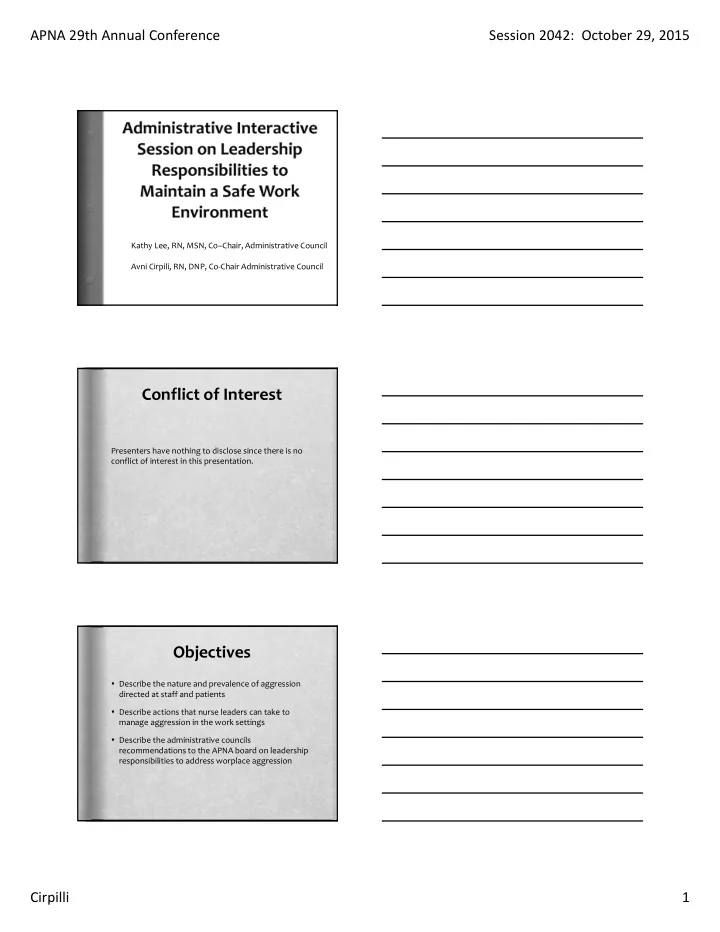

APNA 29th Annual Conference Session 2042: October 29, 2015 Kathy Lee, RN, MSN, Co–Chair, Administrative Council Avni Cirpili, RN, DNP, Co ‐ Chair Administrative Council Conflict of Interest Presenters have nothing to disclose since there is no conflict of interest in this presentation. Objectives Describe the nature and prevalence of aggression directed at staff and patients Describe actions that nurse leaders can take to manage aggression in the work settings Describe the administrative councils recommendations to the APNA board on leadership responsibilities to address worplace aggression Cirpilli 1
APNA 29th Annual Conference Session 2042: October 29, 2015 Prevalence of Workplace Aggressive Incidents Health care support occupations had an injury rate of 20.4 per 10,000 workers due to assaults (U.S. Bureau of Labor Statistics, 2007) 80% of nurses do not feel safe in their workplace (Peek ‐ Asa, et al., 2009) 25% of surveyed psychiatric nurses suffered disabling injuries from patient assaults (Quanbeck, 2006) ANA surveyed 3,765 registered nurses and nursing students 43% of respondents have been verbally and/or physically threatened by a patient or family member of a patient 24% of respondents have been physically assaulted by a patient or family member of a patient while at work (ANA & LCWA Research Group, 2014). 92% of psychiatric nurses expect to be assaulted Violence Definition World Health Organization defines violence as: “the intentional use of physical force or power, threatened or actual, against oneself, another person or against a group or community that either results in or has a high likelihood of resulting in injury, death, psychological harm, mal ‐ development or deprivation.” Workplace Violence Definition Occupational Safety and Health Administration defines violence as: “any physical assault, threatening behavior, or verbal abuse occurring in the work setting.” ANA uses the National Institute for Occupational Safety and Health (NIOSH) definition: “physically and psychologically damaging actions that occur in the workplace or while on duty.” Cirpilli 2
APNA 29th Annual Conference Session 2042: October 29, 2015 Matter of Degree Nonverbal Aggression – Disparaging looks, offensive gestures Verbal harassment, threat or abuse Physical threat – invasion of personal space, physically threatening gestures, Assault – Physical or sexual, any unwanted touch Assault – Battery, Murder, rape Workplace Violence Categories Physical Sexual Verbal Horizontal/Lateral Each of these categories has subcategories and some of the subcategories have subcategories making it very difficult to manage. Risk Assessment Clinical judgment was demonstrated to be unreliable. Variables Static – fixed and historical Dynamic – changeable Instruments became more prevalent still not widely used, examples include Attempted & Actual Assaults Scale Overt Aggression Scale (also has modified version) Dynamic Appraisal of Situational Aggression Broset Violence Checklist – most commonly discussed tool on member bridge Violence Risk Screening ‐ 10 Cirpilli 3
APNA 29th Annual Conference Session 2042: October 29, 2015 Broset Violence Checklist 6 item instrument Two point scale 0 (absent) and 1 (present) Scores for each of the six items are total and risk is assigned by the score: low (0), moderate (1 ‐ 2) and high (3+) Administered after the start of each shift Violence Risk Screening ‐ 10 10 item instrument 3 point scale – 0 (absent), 1 (maybe/moderate), and 2 (yes/definite) Administered at admission and discharge Includes historical, clinical, and future risk assessment Includes both static and dynamic factors Includes clinicians probability statement (low, moderate, and high) Overt Aggression Scale Divided into four categories of aggressive behaviors and a section for interventions Each category has four statements and an observer checks all of the statements that apply Scale is generally completed after an aggressive incident Each statement in the different categories have a score. The total aggression score is obtained by adding the number of most severe behavior in each category and the number for the most restrictive or severe intervention Scale is used to monitor trends in aggression over time Cirpilli 4
APNA 29th Annual Conference Session 2042: October 29, 2015 Impact of Aggression on Patients Care of the patient who was assaultive Care of the patient who assaulted staff Milieu management Impact of Aggression on Staff Support Engagement Debriefing Pursuing Criminal Actions Staff Satisfaction Staff Education Impact on Nursing Leadership Supporting leaders Policy reviews Right staff numbers and mix Cirpilli 5
APNA 29th Annual Conference Session 2042: October 29, 2015 Leadership Actions Management commitment, including the endorsement and visible involvement of top management, provides the motivation and resources to deal effectively with workplace violence. This commitment should include: Demonstrating organizational concern for employee emotional and physical safety and health; Exhibiting equal commitment to the safety and health of workers and patients/clients; Assigning responsibility for the various aspects of the workplace violence prevention program to ensure that all managers, supervisors and employees understand their obligations; Allocating appropriate authority and resources to all responsible parties; Maintaining a system of accountability for involved managers, supervisors and employees; Establishing a comprehensive program of medical and psychological counseling and debriefing for employees experiencing or witnessing assaults and other violent incidents; and Supporting and implementing appropriate recommendations from safety and health committees (OSHA, 2004) Metrics Reactive rather than proactive Thinking outside of the box – currently we look at aggression, seclusion or restraint – no good way to measure actions taken to avoid aggression Benchmarking NDNQI – Assaults HBIPS – Seclusion & Restraint AHRQ Hospital Survey of Patient Safety Culture Staff satisfaction survey Cirpilli 6
APNA 29th Annual Conference Session 2042: October 29, 2015 Recommendations Examine the use of a standardized scale for assessment of aggression risk Identify a standardized metric to use for comparison and a way to collect and compare the data Ensure staff engagement in creating a safe work environment Aggression Huddle after each incident not just those resulting in an adverse outcomes Questions and Discussion Cirpilli 7
Recommend
More recommend